
In electrical engineering, a switch is an electrical component that can disconnect or connect the conducting path in an electrical circuit, interrupting the electric current or diverting it from one conductor to another. The most common type of switch is an electromechanical device consisting of one or more sets of movable electrical contacts connected to external circuits. When a pair of contacts is touching current can pass between them, while when the contacts are separated no current can flow.

A telephone switchboard is a device used to connect circuits of telephones to establish telephone calls between users or other switchboards. The switchboard is an essential component of a manual telephone exchange, and is operated by switchboard operators who use electrical cords or switches to establish the connections.
In telecommunications, a cord circuit is a switchboard circuit in which a plug-terminated cord is used to establish connections manually between user lines or between trunks and user lines. A number of cord circuits are furnished as part of the switchboard position equipment. The cords may be referred to as front cord and rear cord or trunk cord and station cord. In modern cordless switchboards, the cord-circuit function is switch operated and may be programmable.
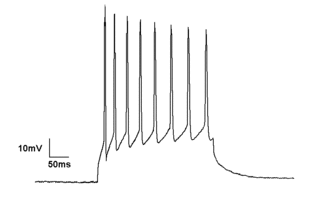
Electrophysiology is the branch of physiology that studies the electrical properties of biological cells and tissues. It involves measurements of voltage changes or electric current or manipulations on a wide variety of scales from single ion channel proteins to whole organs like the heart. In neuroscience, it includes measurements of the electrical activity of neurons, and, in particular, action potential activity. Recordings of large-scale electric signals from the nervous system, such as electroencephalography, may also be referred to as electrophysiological recordings. They are useful for electrodiagnosis and monitoring.
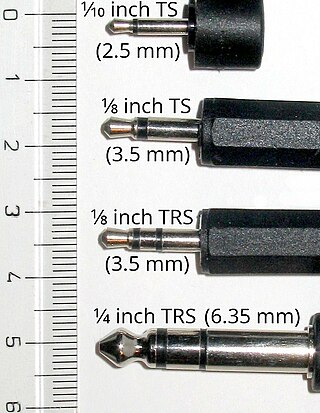
A phone connector is a family of cylindrically-shaped electrical connectors primarily for analog audio signals. Invented in the late 19th century for telephone switchboards, the phone connector remains in use for interfacing wired audio equipment, such as headphones, speakers, microphones, mixing consoles, and electronic musical instruments. A male connector, is mated into a female connector, though other terminology is used.
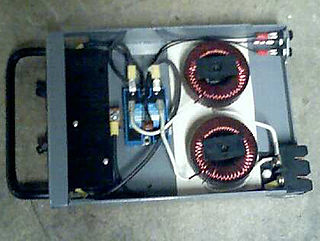
A dimmer is a device connected to a light fixture and used to lower the brightness of the light. By changing the voltage waveform applied to the lamp, it is possible to lower the intensity of the light output. Although variable-voltage devices are used for various purposes, the term dimmer is generally reserved for those intended to control light output from resistive incandescent, halogen, and compact fluorescent lamps (CFLs) and light-emitting diodes (LEDs). More specialized equipment is needed to dim fluorescent, mercury-vapor, solid-state, and other arc lighting.

A residual-current device (RCD), residual-current circuit breaker (RCCB) or ground fault circuit interrupter (GFCI) is an electrical safety device that interrupts an electrical circuit when the current passing through a conductor is not equal and opposite in both directions, therefore indicating leakage current to ground or current flowing to another powered conductor. The device's purpose is to reduce the severity of injury caused by an electric shock. This type of circuit interrupter cannot protect a person who touches both circuit conductors at the same time, since it then cannot distinguish normal current from that passing through a person.
In telecommunications, trunking is a technology for providing network access to multiple clients simultaneously by sharing a set of circuits, carriers, channels, or frequencies, instead of providing individual circuits or channels for each client. This is reminiscent to the structure of a tree with one trunk and many branches. Trunking in telecommunication originated in telegraphy, and later in telephone systems where a trunk line is a communications channel between telephone exchanges.

In the early days of telephony, companies used manual telephone switchboards, and switchboard operators connected calls by inserting a pair of phone plugs into the appropriate jacks. They were gradually phased out and replaced by automated systems, first those allowing direct dialing within a local area, then for long-distance and international direct dialing.

An electric switchboard is a piece of equipment that distributes electric power from one or more sources of supply to several smaller load circuits. It is an assembly of one or more panels, each of which contains switching devices for the protection and control of circuits fed from the switchboard. Several manufacturers make switchboards used in industry, commercial buildings, telecommunication facilities, oil and gas plants, data centers, health care, and other buildings, and onboard large ships. A switchboard is divided into different interconnected sections, generally consisting of a main section and a distribution section. These two sections are sometimes replaced by a combination section, which is a section that can fulfill the roles of both of the aforementioned sections. Switchboards can also sometimes come with an auxiliary section that is used to house devices that cannot be housed in the same section as other devices.

A business telephone system is a telephone system typically used in business environments, encompassing the range of technology from the key telephone system (KTS) to the private branch exchange (PBX).
The Traffic Service Position System (TSPS) was developed by Bell Labs in Columbus, Ohio to replace traditional cord switchboards. The first TSPS was deployed in Morristown, New Jersey in 1969 and used the Stored Program Control-1A CPU, "Piggyback" twistor memory and Insulated Gate Field Effect Transistor solid state memory devices similar to dynamic random access memory.
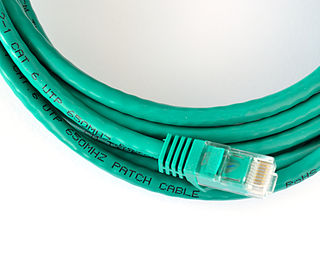
A patch cable, patch cord or patch lead is an electrical or fiber-optic cable used to connect one electronic or optical device to another for signal routing. Devices of different types are connected with patch cords.
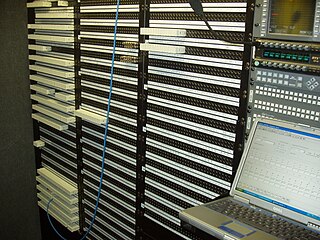
A patch panel is a device or unit featuring a number of jacks, usually of the same or similar type, for the use of connecting and routing circuits for monitoring, interconnecting, and testing circuits in a convenient, flexible manner. Patch panels are commonly used in computer networking, recording studios, and radio and television.

A plugboard or control panel is an array of jacks or sockets into which patch cords can be inserted to complete an electrical circuit. Control panels are sometimes used to direct the operation of unit record equipment, cipher machines, and early computers. The array of holes is often contained in a flat removable panel that can be inserted into a machine and pressed against an array of contacts. This allows the machine to be quickly switched between different applications.

This history of the telephone chronicles the development of the electrical telephone, and includes a brief overview of its predecessors. The first telephone patent was granted to Alexander Graham Bell in 1869.

A transport hub is a place where passengers and cargo are exchanged between vehicles and/or between transport modes. Public transport hubs include railway stations, rapid transit stations, bus stops, tram stops, airports and ferry slips. Freight hubs include classification yards, airports, seaports and truck terminals, or combinations of these. For private transport by car, the parking lot functions as a unimodal hub.

A telephone number is a sequence of digits assigned to a landline telephone subscriber station connected to a telephone line or to a wireless electronic telephony device, such as a radio telephone or a mobile telephone, or to other devices for data transmission via the public switched telephone network (PSTN), or other public and private networks. Modern smart phones have added a built-in layer of abstraction whereby individuals or businesses are saved into a contacts application and the numbers no longer have to be written down or memorized.

A telephone exchange, also known as a telephone switch or central office, is a crucial component in the public switched telephone network (PSTN) or large enterprise telecommunications systems. It facilitates the interconnection of telephone subscriber lines or digital system virtual circuits, enabling telephone calls between subscribers.
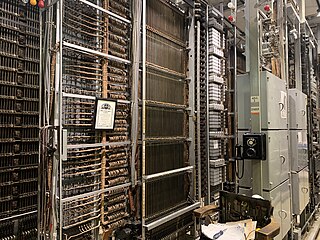
The Panel Machine Switching System is a type of automatic telephone exchange for urban service that was used in the Bell System in the United States for seven decades. The first semi-mechanical types of this design were installed in 1915 in Newark, New Jersey, and the last were retired in the same city in 1983.
![]() This article incorporates public domain material from Federal Standard 1037C. General Services Administration. Archived from the original on 2022-01-22. (in support of MIL-STD-188).
This article incorporates public domain material from Federal Standard 1037C. General Services Administration. Archived from the original on 2022-01-22. (in support of MIL-STD-188).














